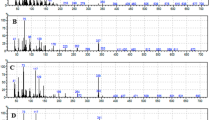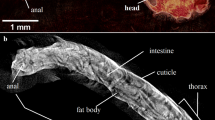Abstract
A NUMBER of phosphorus compounds, some of which have a vital role in vertebrate nerve function, have been demonstrated in the abdominal part of the ventral nerve cord of adult male Periplaneta americana. An estimate of their relative tissue concentrations has been made by the labelled pool technique1. Groups of about ten cockroaches were injected with 400 µc. of carrier-free phosphorus-32 orthophosphate per individual. They were held for seven days on normal diet to permit equilibration between injected phosphorus-32 and phosphorylated metabolites. Part of the nerve cord of each animal was exposed in situ by removing a strip of abdominal wall, separated from the animal by a piece of black paper and dissected free from other tissues, hæmolymph being washed off with Ringer solution. The cord was monitored using a cathode ray oscilloscope to ensure that it was capable of conducting impulses. Each electrically normal cord was raised up on two hooks 8 mm. apart, and the preparation flooded with liquid nitrogen. The frozen cord sample was transferred quickly to a homogenizer tube itself immersed in liquid nitrogen. After breaking up the tissue in 50 per cent ethanol made 1 N with respect to formic acid, the homogenizer was kept at −30° C. for 15 min. to allow thorough penetration of the medium. The tissue was warmed to 5° C., thrice extracted with 0.2 ml. extraction medium, and the extract separated by paper and elution2 chromatography into a number of fractions. By automatic scanning of paper chromatograms1 and Geiger counting of column effluents in solution, the size of each fraction was estimated, the results being expressed as percentages of the extracted phosphorus-32. The principal constituents of the extract were identified by co-chromatography with known substances. Where a fraction was shown to contain substantial impurity, the fact is indicated in Table 1 by a question mark and a ‘less than’ sign, though there may be small amounts of unidentified material in any fraction. About 60 per cent of the total phosphorus-32 of the nerve is extracted by the above procedure. The total phosphorus of cockroach abdominal nerve cord was found to be 1.41 mgm./gm. wet weight using the method of Bartlett3. In calculating approximate tissue concentrations of substances from these data, it has been assumed that the quantities of phosphorus-32 assayed reflect the amounts of phosphorus-31 present, both in the extract and in the insoluble residue. This assumption is not strictly valid, so the figures quoted (Table 1) are an indication of the order of magnitude of concentration of the metabolites listed.
This is a preview of subscription content, access via your institution
Access options
Subscribe to this journal
Receive 51 print issues and online access
$199.00 per year
only $3.90 per issue
Buy this article
- Purchase on Springer Link
- Instant access to full article PDF
Prices may be subject to local taxes which are calculated during checkout
Similar content being viewed by others
References
Winteringham, F. P. W., Proc. of the Intern. Symp. on Microchem., 1958, 305 (Pergamon Press, London, 1960).
Gilbert, D. A., and Yemm, E. W., Nature, 182, 1745 (1958).
Bartlett, G. R., J. Biol. Chem., 234, 466 (1959).
Author information
Authors and Affiliations
Rights and permissions
About this article
Cite this article
HESLOP, J., RAY, J. Nucleotides and Other Phosphorus Compounds of Cockroach Nerve. Nature 190, 1192–1193 (1961). https://doi.org/10.1038/1901192a0
Issue Date:
DOI: https://doi.org/10.1038/1901192a0
This article is cited by
Comments
By submitting a comment you agree to abide by our Terms and Community Guidelines. If you find something abusive or that does not comply with our terms or guidelines please flag it as inappropriate.



